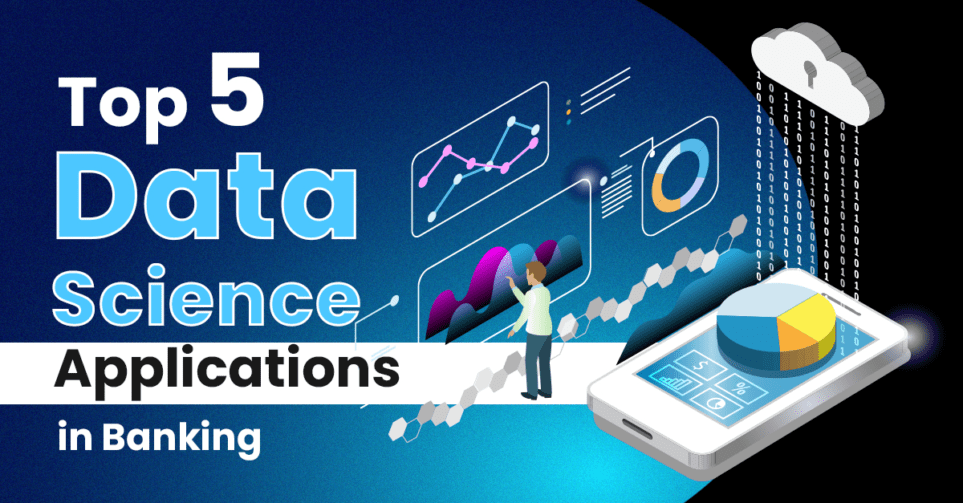In today’s rapidly technologically advancing era. Dependency on the data is significantly increasing. To deal with this a domain known as data science was introduced. Since its inception, it has revolutionized the playing field. It has covered almost every industry ranging from banking to health. In this very blog post, we are going to introduce the top five applications of data science to you. To ace the domain of data science you need a well-structured path as the domain is huge. Check out the Data Science Course and start learning.
Introduction to Data Science
Introduction to Data Science is a comprehensive field that involves the extraction of knowledge and insights from data. It is an interdisciplinary field that blends statistical methods, computer science, and domain-specific knowledge to transform raw data into useful information. Data Science comprises three main stages: data preparation, data analysis, and data interpretation.
Data is gathered, cleansed, and changed into a format that can be analyzed during the data preparation step. This calls for activities like data integration, data wrangling, and data cleansing.
In the data analysis stage, various statistical and machine learning techniques are applied to the prepared data to identify patterns and relationships. This stage involves exploratory data analysis, statistical modeling, and machine learning algorithms.
In the data interpretation stage, the insights obtained from the analysis stage are used to inform decision-making processes. This involves communicating the results of the analysis to stakeholders in a clear and concise manner.
Top Five Applications of Data Science
Customer Segmentation using AIML –
Customer segmentation is a highly demanded application of data science in the banking industry. It helps banks to control large volumes of customer data. Various techniques of data science can help in identifying different customer groups based on their behavior and preferences. This helps banks to personalize their services for different customer segments and provide them with tailored products.
Example –
Consider a bank with huge piles of data. Banks can use data science to segment their customers into different groups based on various parameters including their income levels, age, and spending patterns. They can then offer different credit card options with customized rewards and benefits to each customer segment. By doing this, banks can increase customer engagement and loyalty.
Risk Management –
Risk management is an essential aspect of industries running with the help of the internet and dealing with the high volume of data. With data science, organizations can improve their risk management strategies. These organizations can analyze large amounts of data to identify potential risks and take preventive measures to mitigate them from malicious guys.
Example –
Let’s consider the banking sector as the concerned organization. Banks can use data science techniques to analyze the credit history of a borrower and determine the probability of default. They can also use data science to detect fraud in real-time, which can help in preventing financial losses.
Fraud Detection –
Fraud is a significant concern in the banking industry, as it can cost you your hard-earned money. With data science, banks can identify fraudulent activities and prevent them from happening. Banks can use machine learning algorithms to detect patterns in customer transactions that are indicative of fraud.
Example –
If a customer suddenly makes a large transaction outside of their typical spending patterns, this could be a sign of fraud. Data science techniques can help identify such patterns and alert banks to investigate further and helps them to decide their further actions.
Personalized Marketing –
Personalized marketing is a data science application that can help banks to improve customer engagement and loyalty. Banks can use customer data to identify customer preferences, interests, and behavior. This information can then be used to create personalized marketing campaigns for each customer.
Example –
If a customer frequently uses their credit card for travel, the bank can offer them customized travel-related benefits and discounts. This can help in building customer loyalty and increasing the chances of cross-selling.
Credit Scoring –
Credit scoring is a crucial application of data science in the banking industry. Banks can use data science techniques to analyze the creditworthiness of a borrower and determine their credit score. This can help in making informed lending decisions.
Example –
Banks can use machine learning algorithms to analyze large amounts of data, including credit history, income, and other factors, to determine the probability of a borrower defaulting on a loan. This can help banks to make more accurate lending decisions and reduce the risk of financial losses.
Conclusion
Congratulations on making it to the end of the blog. In this we had in-depth discussion on the various types of applications of data science. Learning about data science will surely help you in securing your future goals. Data science is transforming the banking industry by enabling banks to better understand customer behavior, personalize their services, and identify fraud. By using data science applications like customer segmentation, risk management, fraud detection, personalized marketing, and credit scoring, banks can improve their business operations and offer better services to their customers. As the banking industry continues to evolve, data science will play an increasingly important role in its growth.
To have a strong grip in the domain of data science you should follow a well designed Data Science Training video, and follow it religiously. This is all for this time, we hope that you have learned something new. And it was worth it in investing your time and money.



